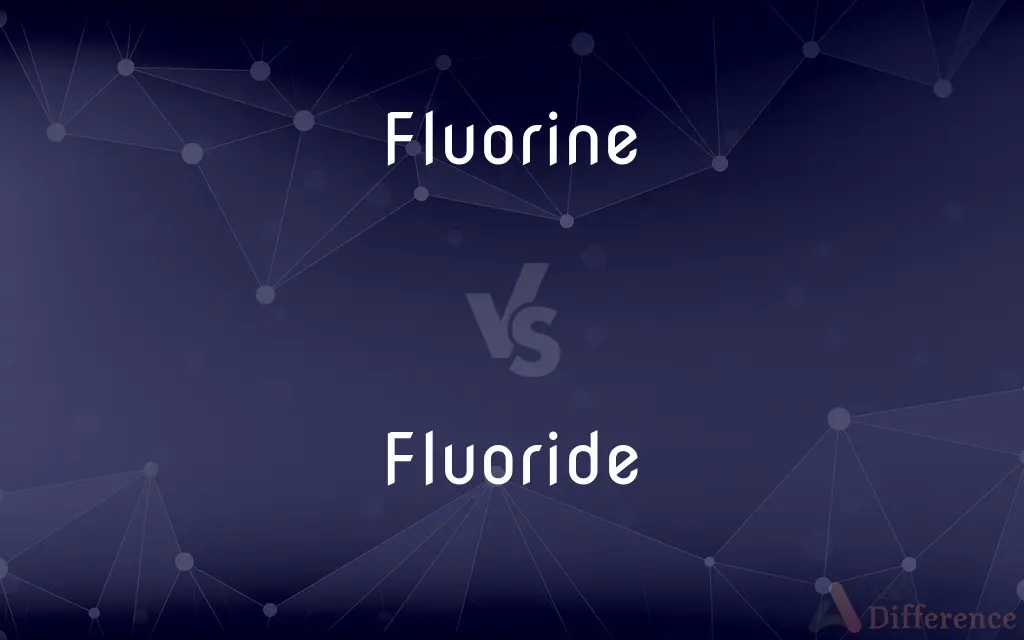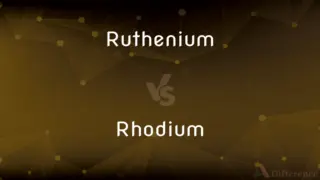Fluorine vs. Fluoride — What's the Difference?
By Tayyaba Rehman — Updated on September 21, 2023
Fluorine is a yellowish, highly reactive gas and the lightest halogen, while fluoride is the anion of fluorine, often found in compounds or dental products.

Difference Between Fluorine and Fluoride
Table of Contents
ADVERTISEMENT
Key Differences
Fluorine is a chemical element represented by the symbol "F" and atomic number 9. It belongs to the halogen group on the periodic table. Fluoride, on the other hand, refers to the negative ion of fluorine, designated as F^-.
In its natural state, fluorine is a pale yellow, poisonous gas that is highly reactive. As such, it's seldom found in its elemental form on Earth. Conversely, fluoride, being an ion of fluorine, often exists combined with other elements to form various compounds.
The reactivity of fluorine can be attributed to its electronegativity, making it eager to acquire electrons from other elements. Fluoride, having already gained an electron, is more stable and commonly found in nature, especially in minerals.
Industrial applications utilize fluorine in various forms, from refining uranium to producing refrigerants. Fluoride, being less reactive, is known for its role in dental health, often added to toothpaste and drinking water to prevent tooth decay.
It's crucial to understand the distinction between the elemental gas fluorine and the ion fluoride, especially in contexts like chemistry and health, as their properties and applications differ significantly.
ADVERTISEMENT
Comparison Chart
Nature
Elemental gas
Anion (ion of fluorine)
Chemical Symbol/Formula
F
F^-
Presence
Rarely found in nature due to high reactivity
Common in minerals and dental products
Reactivity
Highly reactive
Stable, especially when bound in compounds
Use
Refining, producing refrigerants
Tooth decay prevention, in minerals
Compare with Definitions
Fluorine
A chemical element with the symbol F and atomic number 9.
Fluorine is the most electronegative element on the periodic table.
Fluoride
The negative ion of fluorine.
Fluoride is often added to drinking water to promote dental health.
Fluorine
A pale yellow, highly reactive gas.
Pure fluorine is so reactive that it's dangerous to store.
Fluoride
Found in various minerals like fluorite.
Calcium fluoride is the main component of the mineral fluorite.
Fluorine
The lightest of the halogen group.
Fluorine reacts with almost all organic and inorganic substances.
Fluoride
An agent beneficial in reducing tooth decay.
Regular exposure to small amounts of fluoride strengthens tooth enamel.
Fluorine
An element that forms compounds with most other elements.
Many metals form fluorides when exposed to fluorine.
Fluoride
A component in dental products.
Dentists recommend using toothpaste containing fluoride for better oral health.
Fluorine
A substance used in various industrial applications.
Fluorine is utilized in the uranium refining process.
Fluoride
A compound or ion derived from fluorine.
Sodium fluoride is a common compound used in toothpaste.
Fluorine
Fluorine is a chemical element with the symbol F and atomic number 9. It is the lightest halogen and exists at standard conditions as a highly toxic, pale yellow diatomic gas.
Fluoride
Fluoride () is an inorganic, monatomic anion of fluorine, with the chemical formula F− (also written [F]−), whose salts are typically white or colorless. Fluoride salts typically have distinctive bitter tastes, and are odorless.
Fluorine
A pale-yellow, highly corrosive, poisonous, gaseous halogen element, the most electronegative and most reactive of all the elements, existing as a diatomic gas (F2) and used in a wide variety of industrially important compounds. Atomic number 9; atomic weight 18.9984; melting point -219.67°C; boiling point -188.12°C; specific gravity of liquid 1.50 (at boiling point); valence 1. See Periodic Table.
Fluoride
A compound of fluorine with another element or group, especially salt of the anion F⁻ or an organic compound with fluorine bonded to an alkyl group.
Fluorine
(uncountable) The chemical element (symbol F) with an atomic number of 9. It is the lightest of the halogens, a pale yellow-green, highly reactive gas that attacks all metals.
Fluoride
Sodium fluoride or another fluorine-containing salt added to water supplies or toothpaste in order to reduce tooth decay.
Fluorine
A single atom of this element.
An octahedron of fluorines
Fluoride
Univalent fluorine, or a compound of fluorine, especially a binary compound of fluorine with a more electropositive element.
Fluorine
A non-metallic, gaseous element of atomic number 9, strongly acid or negative, and associated with chlorine, bromine, and iodine, in the halogen group of which it is the first member. It always occurs combined, is very active chemically, and possesses such an avidity for most elements, and silicon especially, that it can neither be prepared nor kept in glass vessels, but may be contained in lead vessels. If set free it immediately attacks a containing glass vessel, so that it was not isolated until 1886. It is a pungent, corrosive, colorless gas. Symbol F. Atomic weight 19.00.
Fluoride
(chemistry) Any salt of hydrofluoric acid; for example, potassium fluoride.
Fluorine
A nonmetallic univalent element belonging to the halogens; usually a yellow irritating toxic flammable gas; a powerful oxidizing agent; recovered from fluorite or cryolite or fluorapatite
Fluoride
(chemistry) A binary compound of fluorine and another element or radical.
Fluoride
A binary compound of fluorine with another element or radical.
Fluoride
A salt of hydrofluoric acid
Common Curiosities
How is fluoride beneficial for teeth?
Fluoride helps remineralize tooth enamel, making it more resistant to decay.
Is pure fluorine dangerous?
Yes, pure fluorine is highly reactive and can be dangerous to handle.
Can fluorine exist freely in nature?
Due to its reactivity, fluorine does not exist freely in nature but is found in various compounds.
What is the atomic number of fluorine?
The atomic number of fluorine is 9.
Why is fluoride added to toothpaste?
Fluoride is added to toothpaste to help prevent tooth decay and strengthen enamel.
Share Your Discovery

Previous Comparison
Commitment vs. Accountability
Next Comparison
Ruthenium vs. RhodiumAuthor Spotlight
Written by
Tayyaba RehmanTayyaba Rehman is a distinguished writer, currently serving as a primary contributor to askdifference.com. As a researcher in semantics and etymology, Tayyaba's passion for the complexity of languages and their distinctions has found a perfect home on the platform. Tayyaba delves into the intricacies of language, distinguishing between commonly confused words and phrases, thereby providing clarity for readers worldwide.













































